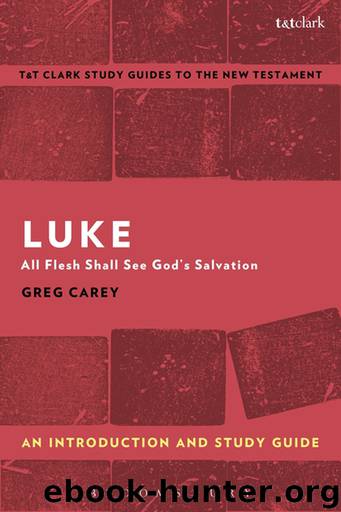Luke: An Introduction and Study Guide by Greg Carey

Author:Greg Carey
Language: eng
Format: epub
Publisher: Bloomsbury
Published: 2017-02-27T16:00:00+00:00
Evil and Sin
Luke presents Jesus as Savior and emphasizes salvation. But salvation from what? What basic problems confront humanity? Luke does not dwell systematically on the causes of evil or the nature of sin, but certain emphases do develop within the narrative.
We begin by considering Jesus’ characteristic actions. When John’s representatives ask Jesus whether he is ‘the one’, his reply neatly summarizes his activity. People receive healing, and the poor have good news brought to them (7.22). Jesus addresses the obvious problems of human suffering, from pain and disability to oppression and alienation. As interpreters now recognize, Luke does not regard sickness and disability as straightforward medical problems. These conditions – in addition to death, Jesus names blindness, limited mobility, leprosy, and deafness – all imply social and psychological consequences. Jesus’ characteristic activities, healing and teaching, address humankind’s basic needs.
Jesus’ claim, ‘the poor have good news brought to them’, further suggests a rift in human solidarity. Everyone is subject to sickness and disability, but the poor are more likely to suffer infirmity than are the rich. Moreover, while the rich enjoy greater resources to mitigate the suffering caused by sickness or disability, the poor suffer the full brunt of their condition. But it is not simply a matter of luck. For Luke, poverty and prosperity are intimately related to one another. Only in that light does it make sense for Mary to celebrate the mighty being pulled down from their thrones while the lowly are lifted up and the rich being sent away empty while the poor are filled. Only if the poverty of some is caused by the wealth of others is it reasonable for Jesus to bless the poor and pronounce woe to the rich. Where Matthew reveals Jesus’ birth to privileged ‘wise men’, it is no accident that Luke directs the revelation to lowly shepherds. One significant dimension of human suffering, for Luke, involves conditions of exploitation, oppression, and stratification.
This dimension of human suffering may account for other characteristic activities of Jesus. Jesus builds community by traveling and by sending his disciples out on mission. Such face to face interaction builds networks of mutuality and accountability (Grimshaw 1999). Jesus is frequently seen at meals (Karris 2006). There he undermines social conventions that sustain relationships among the privileged but exclude common people. When you host a meal, Jesus says, invite not your ‘rich neighbors’ but ‘the poor, the crippled, the lame, and the blind’ (14.12-14). Jesus’ characteristic companionship with sinners, a point of emphasis for Luke, undermines systems that identify some persons as outcasts while maintaining respectability and status for others (Carey 2009).
One further dimension of human suffering involves exploitation by governments and other authorities. Luke does portray aggressive human cruelty. Luke reminds us how powerful forces exploit people, conducting a census to streamline the process of oppression (2.1-3). A tyrant like Herod imprisons and then executes the prophet John for calling attention to his wicked deeds. In a story that cannot be confirmed in other ancient sources, Pilate not only massacres a group of Galileans, he does so as they were offering sacrifices (13.
Download
This site does not store any files on its server. We only index and link to content provided by other sites. Please contact the content providers to delete copyright contents if any and email us, we'll remove relevant links or contents immediately.
| Guides | New Testament |
| Old Testament |
The Five People You Meet in Heaven by Mitch Albom(3336)
Real Sex by Lauren F. Winner(2867)
Name Book, The: Over 10,000 Names--Their Meanings, Origins, and Spiritual Significance by Astoria Dorothy(2840)
The Holy Spirit by Billy Graham(2777)
The Secret Power of Speaking God's Word by Joyce Meyer(2754)
ESV Study Bible by Crossway(2672)
How The Mind Works by Steven Pinker(2612)
0041152001443424520 .pdf by Unknown(2599)
Ancient Worlds by Michael Scott(2496)
The ESV Study Bible by Crossway Bibles(2420)
The Gnostic Gospels by Pagels Elaine(2399)
The Meaning of the Library by unknow(2386)
Churchill by Paul Johnson(2368)
MOSES THE EGYPTIAN by Jan Assmann(2277)
City of Stairs by Robert Jackson Bennett(2233)
Jesus by Paul Johnson(2229)
The Complete Dead Sea Scrolls in English (7th Edition) (Penguin Classics) by Geza Vermes(2136)
Ancient Near Eastern Thought and the Old Testament by John H. Walton(2131)
The Nativity by Geza Vermes(2115)
